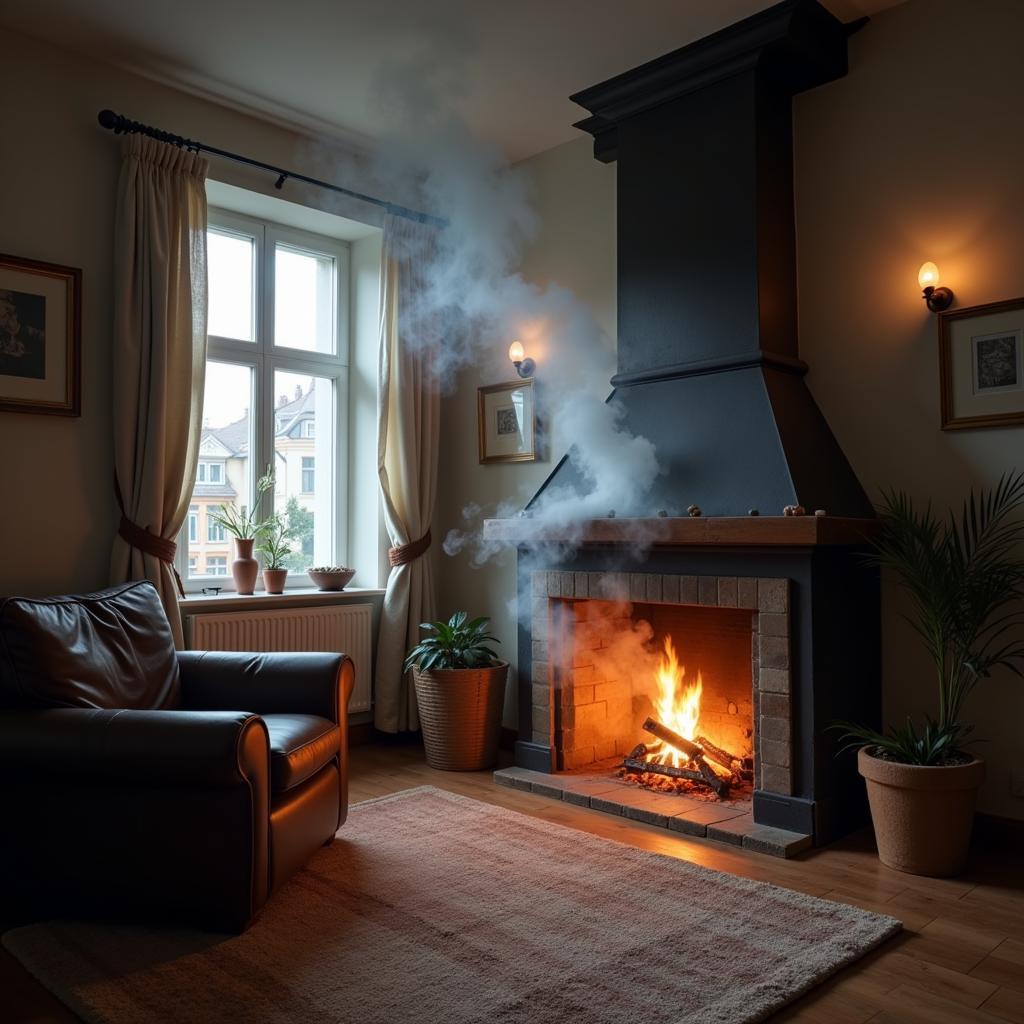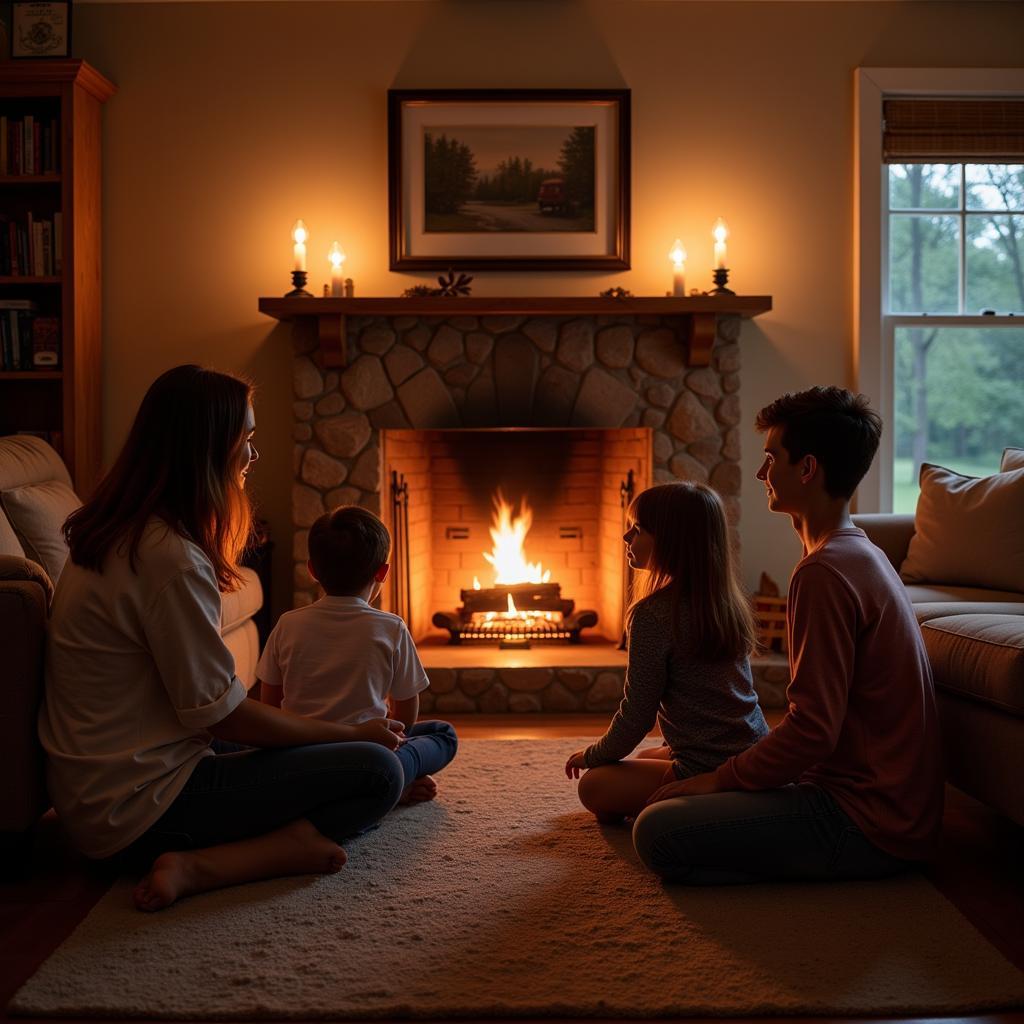Smoke Not Going Up the Chimney: Understanding the Causes and Solutions
October 15, 2024The sight of smoke billowing from your chimney is a familiar and comforting one, a testament to a cozy fire and a warm home. But what happens when the smoke decides to take a detour, refusing to ascend the chimney as it should? A “Smoke Not Going Up The Chimney” scenario can be more than just an inconvenience; it can signal a potentially dangerous situation within your home.
 Smoke-filled living room with fireplace
Smoke-filled living room with fireplace
Decoding the Smoke Signals: Common Causes of Chimney Smoke Backdraft
Chimney smoke backdraft, the unwelcome guest that brings smoke back into your living space, can stem from a variety of culprits. Identifying the root cause is the first step toward breathing easy again. Let’s delve into some of the usual suspects:
- Creosote Buildup: Over time, a sticky, flammable substance known as creosote can accumulate on the interior walls of your chimney. This buildup narrows the flue (the passageway for smoke), restricting airflow and increasing the likelihood of backdrafting.
- Obstructions in the Chimney: Blockages, whether from bird nests, animal debris, or even fallen bricks, can obstruct the free flow of smoke, forcing it back down the chimney.
- Negative Air Pressure: A well-functioning fireplace relies on a delicate balance of air pressure. When the air pressure inside your home is lower than the pressure outside, it can create a vacuum-like effect, pulling smoke back into the living space.
- Cold Air in the Chimney: A cold chimney can hinder the proper draft needed to draw smoke upwards. This is particularly common during colder months or when the fireplace hasn’t been used in a while.
Taming the Smoke: Effective Solutions for Chimney Backdraft
Once you’ve pinpointed the culprit behind your chimney woes, it’s time to implement effective solutions. Remember, safety is paramount, and consulting a certified chimney sweep or professional is always recommended, especially if you suspect a serious issue.
- Professional Chimney Cleaning: Regular chimney cleaning is the cornerstone of fireplace safety and efficiency. A certified chimney sweep will remove creosote buildup and any obstructions, ensuring a clear passage for smoke.
- Chimney Cap Installation: A chimney cap acts as a shield against external elements, preventing debris, rain, and animals from entering and obstructing the flue.
- Addressing Air Pressure Imbalance: Opening a window slightly while using the fireplace can help balance air pressure, allowing smoke to escape more readily.
- Priming the Chimney: Before starting a fire, especially in colder weather, consider priming the chimney by warming it up with a rolled-up newspaper or a chimney starter. This helps establish an upward draft.
 Certified chimney sweep inspecting a flue for creosote buildup
Certified chimney sweep inspecting a flue for creosote buildup
Recognizing the Warning Signs: When to Call for Professional Help
While some chimney backdraft issues can be addressed with simple solutions, certain signs warrant immediate professional attention:
- Persistent Smoke Backdraft: If you experience frequent or continuous smoke backdraft, it’s crucial to seek professional help to rule out any underlying structural issues or hazards.
- Strange Odors: Foul or unusual odors emanating from the fireplace can indicate a blockage or the presence of dangerous gases.
- Visible Damage: Cracks in the chimney structure, loose bricks, or other visible damage require prompt professional repair to ensure safety.
Beyond the Smoke: Maintaining a Healthy Chimney
Preventing chimney problems begins with proactive maintenance. Here are some essential tips to keep your chimney in tip-top shape:
- Annual Inspections: Schedule a professional chimney inspection annually, ideally before the start of the colder months when fireplace usage increases.
- Proper Firewood Selection: Use seasoned firewood, which has been dried for at least six months, as it burns cleaner and produces less creosote.
- Avoid Overloading the Fireplace: Burning excessive amounts of wood can contribute to creosote buildup.
- Install Carbon Monoxide Detectors: Carbon monoxide is a colorless, odorless gas that can be fatal. Ensure you have working carbon monoxide detectors installed on every level of your home, especially near sleeping areas.
 Family enjoying a safe and cozy fireplace in their living room
Family enjoying a safe and cozy fireplace in their living room
Conclusion: Embracing Fireplace Safety and Enjoying the Warmth
A fireplace can be a source of immense warmth, ambiance, and cherished memories. By understanding the causes of chimney backdraft and implementing preventive measures, you can enjoy your fireplace safely and confidently. Remember, regular maintenance, professional inspections, and prompt attention to any warning signs are key to ensuring a warm and worry-free experience.
For any assistance or inquiries regarding fireplace safety and maintenance, please do not hesitate to contact us. Our team of experts is available 24/7 to address your concerns and provide tailored solutions. You can reach us at Phone Number: 0915117113, Email: [email protected], or visit us at Address: To 3 Kp Binh An, Phu Thuong, Viet Nam, Binh Phuoc 830000, Viet Nam.